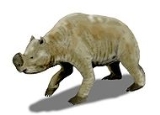
Zygomaturus
Encyclopedia

Marsupial
Marsupials are an infraclass of mammals, characterized by giving birth to relatively undeveloped young. Close to 70% of the 334 extant species occur in Australia, New Guinea, and nearby islands, with the remaining 100 found in the Americas, primarily in South America, but with thirteen in Central...
from Australia
Australia
Australia , officially the Commonwealth of Australia, is a country in the Southern Hemisphere comprising the mainland of the Australian continent, the island of Tasmania, and numerous smaller islands in the Indian and Pacific Oceans. It is the world's sixth-largest country by total area...
during the Pleistocene
Pleistocene
The Pleistocene is the epoch from 2,588,000 to 11,700 years BP that spans the world's recent period of repeated glaciations. The name pleistocene is derived from the Greek and ....
. It had a heavy body and thick legs and is believed to be similar to the modern Pygmy Hippopotamus
Pygmy Hippopotamus
The pygmy hippopotamus is a large mammal native to the forests and swamps of western Africa . The pygmy hippo is reclusive and nocturnal...
in both size and build. The genus moved on all fours. It lived in the wet coastal margins
Continental margin
The continental margin is the zone of the ocean floor that separates the thin oceanic crust from thick continental crust. Continental margins constitute about 28% of the oceanic area....
of Australia and became extinct about 45,000 years ago. Zygomaturus also is believed to have expanded its range toward the interior of the continent
Continent
A continent is one of several very large landmasses on Earth. They are generally identified by convention rather than any strict criteria, with seven regions commonly regarded as continents—they are : Asia, Africa, North America, South America, Antarctica, Europe, and Australia.Plate tectonics is...
along the waterways. It is believed to have lived solitarily or possibly in small herds. Zygomaturus probably ate reeds
Reed (plant)
Reed is a generic polyphyletic botanical term used to describe numerous tall, grass-like plants of wet places, which are the namesake vegetation of reed beds...
and sedge
Cyperaceae
Cyperaceae are a family of monocotyledonous graminoid flowering plants known as sedges, which superficially resemble grasses or rushes. The family is large, with some 5,500 species described in about 109 genera. These species are widely distributed, with the centers of diversity for the group...
s by shoveling them up in clumps with its lower incisor teeth.
Related species
|
Neohelos Neohelos is an extinct sheep-sized marsupial from the late Oligocene to middle-Miocene aged deposits of Bullock Creek in the Northern Territory, Lake Ngapakaldi South Australia and riversleigh of Queensland. There are four species in this genera, N. tirarensis from Bullock Creek and the... Kolopsis Kolopsis is an extinct genus of diprotodontid marsupials from Australia. It contains three species:*†Kolopsis rotundus Plane 1967*†Kolopsis torus Woodburne, 1967*†Kolopsis yperus Murray, Megirian & Wells, 1993K... |
Further reading
- Wildlife of Gondwana: Dinosaurs and Other Vertebrates from the Ancient Supercontinent (Life of the Past) by Pat Vickers Rich, Thomas Hewitt Rich, Francesco Coffa, and Steven Morton
- Marsupial Nutrition by Ian D. Hume
- Prehistoric Mammals of Australia and New Guinea: One Hundred Million Years of Evolution by John A. Long, Michael Archer, Timothy Flannery, and Suzanne Hand
- Life of Marsupials by Hugh Tyndale-Biscoe
- Magnificent Mihirungs: The Colossal Flightless Birds of the Australian Dreamtime (Life of the Past) by Peter F. Murray, Patricia Vickers-Rich, and Pat Vickers Rich
- Classification of Mammals by Malcolm C. McKenna and Susan K. Bell
- Australia's Lost World: Prehistoric Animals of Riversleigh by Michael Archer, Suzanne J. Hand, and Henk Godthelp
- World Encyclopedia of Dinosaurs & Prehistoric Creatures: The Ultimate Visual Reference To 1000 Dinosaurs And Prehistoric Creatures Of Land, Air And Sea ... And Cretaceous Eras (World Encyclopedia) by Dougal Dixon
- The Illustrated Encyclopedia Of Prehistoric Life by Dougal Dixon

